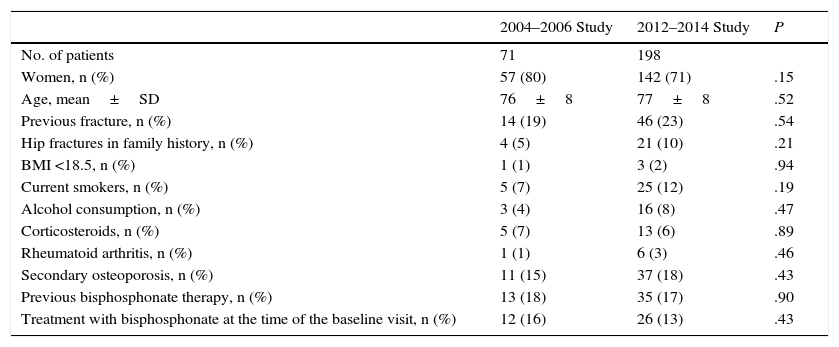Osteoporosis and its consequence, bone fractures, are increasing due to the aging of the population, to the extent that, over the next decade, there will be 347564 hip fractures (263351 in women).1 Five years after fracturing a hip, 14% of the patients will sustain a new hip fracture, whereas 32% will sustain fractures elsewhere in the body.2 However, even though the patients are elderly, drug therapy reduces the risk of refracture by 39% and the risk of death by 55%.3 In 2004, in the North Health Area of Gran Canaria, in the Canary Islands, Spain, we carried out a program to prevent fractures that consisted in giving all the patients over 50 years of age who had sustained a fragility fracture appointments to undergo bone densitometry and to visit a rheumatologist.4 In 2012, we implemented a model that was directed by a nurse and coordinated by rheumatologists, in collaboration with the primary care physicians.5 Our institution offers coverage to a population of roughly 450000 and there are 22 primary care centers linked to the hospital.
We selected all the patients who had hip fractures and had been enrolled in the 2004–2006 program and the 2012–2014 program (a total of 269 cases) to analyze the outcome of a decade of secondary prevention. On average, the initial visit took place 6 months after the fracture in both studies. Data collection was carried out by five rheumatologists during the period from 2004 to 2006, and by a nurse from 2012 to 2014. The risk factors for fracture recorded during the two periods are shown in Table 1, in which the characteristics of the two groups are similar. In both periods, at the time of the first visit, less than 20% of the patients were taking a bisphosphonate.
Characteristics of the Patients With Hip Fracture During Two Periods of Observation.
| 2004–2006 Study | 2012–2014 Study | P | |
|---|---|---|---|
| No. of patients | 71 | 198 | |
| Women, n (%) | 57 (80) | 142 (71) | .15 |
| Age, mean±SD | 76±8 | 77±8 | .52 |
| Previous fracture, n (%) | 14 (19) | 46 (23) | .54 |
| Hip fractures in family history, n (%) | 4 (5) | 21 (10) | .21 |
| BMI <18.5, n (%) | 1 (1) | 3 (2) | .94 |
| Current smokers, n (%) | 5 (7) | 25 (12) | .19 |
| Alcohol consumption, n (%) | 3 (4) | 16 (8) | .47 |
| Corticosteroids, n (%) | 5 (7) | 13 (6) | .89 |
| Rheumatoid arthritis, n (%) | 1 (1) | 6 (3) | .46 |
| Secondary osteoporosis, n (%) | 11 (15) | 37 (18) | .43 |
| Previous bisphosphonate therapy, n (%) | 13 (18) | 35 (17) | .90 |
| Treatment with bisphosphonate at the time of the baseline visit, n (%) | 12 (16) | 26 (13) | .43 |
BMI, body mass index; SD, standard deviation.
The results of the present analysis show that, over a decade, there has been no progress in secondary prevention after a hip fracture. However, the findings encourage us to continue with the implementation of a model of patient care to oversee fracture prevention in this health area. The model consists of a secondary prevention unit for patients >50 years of age who have sustained a fragility fracture and, in the specific case of the hip, are receiving support from the orthogeriatric unit and the rehabilitation service.
A retrospective study conducted in Spain found that only 12% of the patients with a fractured hip received adequate treatment for osteoporosis at 5 years of follow-up,6 when the guidelines recommend treating all hip fracture patients.7 Secondary fracture prevention has been found to be cost-effective8; moreover, several post-fracture secondary prevention programs have been successfully carried out in different countries.9
In conclusion, over the last 10 years, the proportion of patients who receive treatment after a hip fracture remained under 20% in our province. One of the limitations of this study is the selection bias, as the patients analyzed do not represent all the hip fractures recorded during that period, but those patients who were interest in the study; in any case, we understand that the oldest patients with the greatest disability did not participate in the studies and the rate of treatment could be lower than that reported here. The low prescription rate in routine clinical practice is further evidence of the need to create fracture units or a fracture liaison service in Spain. We consider that this is an opportunity to broaden the field of rheumatology with active participation in secondary fracture prevention.
Conflicts of InterestThe authors declare they have no conflicts of interest related to this work.
Please cite this article as: Naranjo A, Ojeda-Bruno S, Bilbao Cantarero A, Rodríguez-Moreno S. Prevención secundaria de fracturas tras fractura de fémur en el área norte de Gran Canaria: comparativa 2004–2014. Reumatol Clin. 2016;12:58.
Scholarship: National Project of the Ministry of Science and Innovation. Carlos III Health Institute: PI11/01429.






